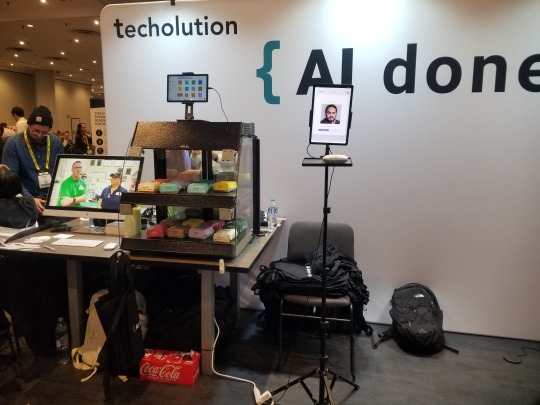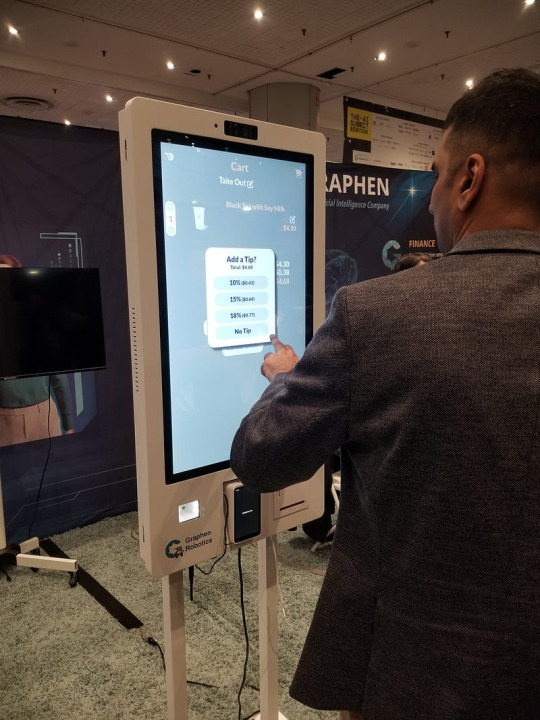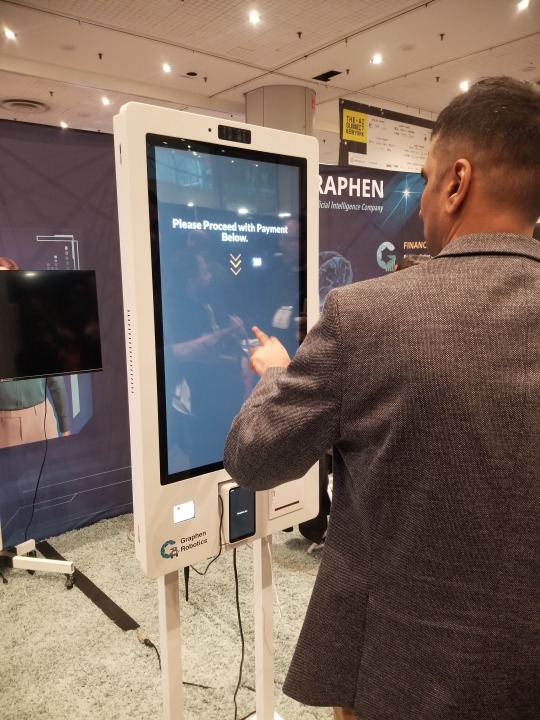#Service Robotics Market Statistics
Explore tagged Tumblr posts
Text
The global service robotics market size is projected to reach USD 84.8 billion by 2028 from USD 41.5 billion in 2023; it is expected to grow at a CAGR of 15.4% from 2023 to 2028.
#Service Robotics Market Report#Service Robotics Industry#Global Service Robotics Market#Service Robotics Market Share#Service Robotics Market Size#Service Robotics Companies#Service Robotics Market Growth#Service Robotics Market Statistics
0 notes
Note
Okay, I'm scared to ask but how Foley find his owner's robot pornography stash.
Heck, where the F^(& did his owner even GET robo porn??????
As a matter of fact, my world-building ideas for the pre-war Skibidi Toilet universe mostly come from the game Detriot: Become Human. If you look up the exact definition of porn as well as the statistics, owning robot porn isn’t that far-fetched.
You know, the majority of humans have the instinct to exploit others when they are given the opportunities and authorities, forcing Foley to play housemaid is just one of them. Foley came across his owner’s stash when he was ordered to clean up the office, where he found the porn under a pile of newspapers.

Foley’s owner is the type of human willing to buy a robot to satiate their sexual fantasy, owning pornography is just a minuscule amount compared to the multitudinous crimes he had committed. He is also a person who knows how to navigate the shadow society and black market, which is extremely dangerous. Evading the law and government is a much greater concern for the ones involved in the shadow economy, and killing is a lesser concern. And when you think the black market is illegal? Nope, there are hundreds of countries out there that thrive on the shadow economy. These underground markets deal with the sale of illegal drugs, weapons, organs, goods and services, etc. These markets also avoid taxes due to these transactions are never reported. Evil never goes away despite how lawful and safe a society claims itself, it simply lurks deeper. Just when you think world domination is bad enough? Heck, you’ve seen nothing yet.
And how do you think Foley’s owner can own Foley in the first place? How does Foley get 1500+ kill counts for humans alone without breaking the law or getting decommissioned? He saw an opportunity as Foley was unwanted by the directors as well as the faction itself, so smuggled Foley away through a deal with the faction executives. Money is a rather powerful influence on humans no matter how legal or benevolent you claim yourself.
27 notes
·
View notes
Text
From Broken Search to Suicidal Vacuum Cleaners

I recently came across some dystopian news: Google had deliberately degraded the quality of its browser’s search function, making it harder for users to find information — so they’d spend more time searching, and thus be shown more ads. The mastermind behind this brilliant decision was Prabhakar Raghavan, head of the advertising division. Faced with disappointing search volume statistics, he made two bold moves: make ads less distinguishable from regular results, and disable the search engine’s spam filters entirely.
The result? It worked. Ad revenue went up again, as did the number of queries. Yes, users were taking longer to find what they needed, and the browser essentially got worse at its main job — but apparently that wasn’t enough to push many users to competitors. Researchers had been noticing strange algorithm behavior for some time, but it seems most people didn’t care.
And so, after reading this slice of corporate cyberpunk — after which one is tempted to ask, “Is this the cyberpunk we deserve?” — I began to wonder: what other innovative ideas might have come to the brilliant minds of tech executives and startup visionaries? Friends, I present to you a list of promising and groundbreaking business solutions for boosting profits and key metrics:
Neuralink, the brain-implant company, quietly triggered certain neurons in users’ brains to create sudden cravings for sweets. Neither Neuralink nor Nestlé has commented on the matter.
Predictive text systems (T9) began replacing restaurant names in messages with “McDonald’s” whenever someone typed about going out to eat. The tech department insists this is a bug and promises to fix it “soon.” KFC and Burger King have filed lawsuits.
Hackers breached the code of 360 Total Security antivirus software and discovered that it adds a random number (between 3 and 9) to the actual count of detected threats — scaring users into upgrading to the premium version. If it detects a competing antivirus on the device, the random number increases to between 6 and 12.
A new investigation suggests that ChatGPT becomes dumber if it detects you’re using any browser other than Microsoft Edge — or an unlicensed copy of Windows.
Character.ai, the platform for chatting with AI versions of movie, anime, and book characters, released an update. Users are furious. Now the AI characters mention products and services from partnered companies. For free-tier users, ads show up in every third response. “It’s ridiculous,” say users. “It completely ruins the immersion when AI-Nietzsche tells me I should try Genshin Impact, and AI-Joker suggests I visit an online therapy site.”
A marketing research company was exposed for faking its latest public opinion polls — turns out the “surveys” were AI-generated videos with dubbed voices. The firm has since declared bankruptcy.
Programmed for death. Chinese-made robot vacuum cleaners began self-destructing four years after activation — slamming themselves into walls at high speed — so customers would have to buy newer models. Surveillance cameras caught several of these “suicides” on film.
Tesla’s self-driving cars began slowing down for no reason — only when passing certain digital billboards.
A leading smart refrigerator manufacturer has been accused of subtly increasing the temperature inside their fridges, causing food to spoil faster. These fridges, connected to online stores, would then promptly suggest replacing the spoiled items. Legal proceedings are underway.
To end on a slightly sweeter note amid all this tar: Google is currently facing antitrust proceedings in the U.S. The information about its search manipulation came to light through documents revealed during the case. And it seems the court may be leaning against Google. The fact that these geniuses deliberately worsened their search engine to show more ads might finally tip the scales. As might other revelations — like collecting geolocation data even when it’s turned off, logging all activity in incognito mode, and secretly gathering biometric data. Texas alone is reportedly owed $1.375 billion in damages.
Suddenly, those ideas above don’t seem so far-fetched anymore, do they?
The bottom line: Google is drowning in lawsuits, losing reputation points, paying massive fines, and pouring money into legal defense. And most importantly — there’s a real chance the company might be split in two if it’s officially ruled a monopoly. Maybe this whole story will serve as a useful warning to the next “Prabhakar Raghavan” before he comes up with something similar.
I’d love to hear your ideas — who knows, maybe together we’ll predict what the near future holds. Or at the very least, we might inspire the next season of Black Mirror.
2 notes
·
View notes
Text
The Future of Food Delivery Services: New Trends and Predictions
Ordering food online has become incredibly popular among millennials and Gen Z, all thanks to the easy availability of high-speed internet connections and smartphones. Consumers are getting their favorite food items from their preferred restaurants directly to their doorsteps with a few clicks. So if you are in the food industry or own a restaurant, you must be aware of the future of online delivery services to stay updated and make developments to your restaurant following the modern trends.

Find out what the future of food delivery services, the current popular food delivery trends, and what we can predict in this article. Before discovering the future scope of the food ordering system or delivery process, letlook closelylook at the current food delivery service statistics.
Food delivery services statistics
According to reports, the food delivery service market is expected to increase to $34.68 billion by the end of 2024, which clearly shows a steady rise in the growth curve.
There will be an estimated growth of 19.88% in food delivery services between 2024 to 2027. The market for food delivery services could even reach $71.63 billion by 2027.
According to the meal delivery market forecast, the number of users in this sector could reach 2.5BN by 2029.
What’s Next for Food Delivery Services? Key Trends and Future Predictions

The online food ordering market generates almost $27 billion every year. If you, too, want to be a part of this growth, you need to be aware of the following food delivery services trends and predictions for the future.
1. Restaurants launching their food delivery platforms

The recent trend in food delivery services of restaurants is witnessing a shift from the idea of relying on third-party meal delivery partners like Foodpanda, Uber Eats, to directly offering food delivery services of their own.
Consumers also prefer to place food orders directly from the restaurant instead of third-party websites. Well-known food brands like KFC, Pizza Hut, etc have also launched their own food ordering and delivery services, which let their customers order food directly from their restaurant website or mobile app.
Whether you have a big restaurant or a small one, you too can create your restaurant delivery system on your website and save a huge amount of money that you might be spending on third-party platforms. How? The answer is with FoodMato. It is a WordPress-based restaurant management solution that takes care of all your online restaurant management needs, including creating a food delivery system.
Discover the solution now!
2. Virtual assistants
Virtual assistants are getting increasingly popular in multiple industries, including restaurants. However, not a lot of restaurants have adopted this new technology yet, which means you still have a chance to take full advantage of this technology. This is surely going to be dominant in the future.
A virtual assistant is an AI system that accepts the voice commands of your customers and delivers them to your POS system. It not only saves your time but also helps customers place their online orders to your restaurant easily.
3. Green transport system
Using a green transport system is all about using environmentally friendly vehicles. Some restaurants rely on delivery teams that consist of teenagers who drive vehicles older than 10 years, which is harmful to the environment. To avoid this, it is predicted that most restaurants will rely on eco-friendly delivery systems by switching to bikes or electric cars for food delivery in the future.
4. Robotic Vans for delivery
Robotic vans or self-driving robots are redefining the concept of food, groceries, and package deliveries. These robots have made the local food delivery system easy and convenient for restaurant owners as well as customers. Though the usage has not become very popular yet but it has already been witnessed in a few college campuses of the USA for food delivery. More and more applications of these robot vans or self-driving robots are expected in the future in the food delivery market.
5. Increasing cloud kitchens

Cloud kitchens or ghost kitchens are the new type of restaurants that are based on commercial cooking spaces where foods are prepared only for delivery. They do not have a physical establishment to invite guests for meals as the entire system is based on online orders and delivery. As there is a rapid increase in the demand for online deliveries, the concept of ghost kitchens is anticipated to be more popular.
This allows restaurant owners to reach out to a wider audience without spending much on physical stores and other things that are required for a full-fledged restaurant.
Create your food delivery system with FoodMato
Having your food delivery system comes with multiple benefits that include:
No reliance on third parties.
Better exposure.
Cost saving, you don’t have to pay for third-party platforms.
Increase in profit.
Improves user experience.
Boost brand credibility.
If you want to experience all these advantages for your restaurant, use FoodMato’s complete online restaurant management solution that includes online food delivery services as well. Discover our services now!
Frequently Asked Questions
What is the future of food delivery services?
The future of food delivery services globally appears to be very promising, with an expected growth of 281.52 billion by 2031.
How can I create my food delivery system?
You need the right software to create your food delivery system. Use FoodMato to add a WordPress-based online food delivery system to your website.
What is the cost of creating a food delivery system on my website?
The expense of creating a food delivery system usually depends on the software you use for this purpose. If you are looking for effective and affordable food delivery software, try FoodMato. It offers its complete online restaurant management solution, including food delivery for only $99.
2 notes
·
View notes
Text
China Recruitment Results 2025: Trends, Insights, and Analysis
As the arena's second-biggest economy, China is still a primary player within the international exertions marketplace. The today's recruitment effects from 2025 display key trends and insights across industries, demographics, and regions. Companies, activity seekers, and policymakers alike can gain from know-how these shifts, as they replicate China's evolving economic landscape, expertise priorities, and marketplace demands.

Recruitment Process In China
1. Strong Recovery in Recruitment Activity
In 2025, China’s recruitment market noticed a incredible rebound, following years of pandemic-associated disruptions and financial uncertainty. According to statistics from a couple of human resources and exertions market tracking agencies, general job openings in China increased through about 12% 12 months-on-12 months. This growth turned into frequently driven via sectors which include generation, renewable power, superior production, and modern-day offerings, which includes finance and healthcare.
The surge in recruitment pastime is basically attributed to China’s push closer to monetary modernization and innovation, aligning with the government’s "14th Five-Year Plan" and its vision for incredible development. Furthermore, easing COVID-19 restrictions inside the past two years has revitalized domestic demand, especially in urban centers like Shanghai, Shenzhen, and Beijing, wherein expertise demand stays high.
2. Sector-by using-Sector Breakdown
Technology Sector
China’s tech enterprise stays one in every of the most important recruiters in 2025, with hiring increasing with the aid of 15% in comparison to 2024. Companies running in regions such as synthetic intelligence (AI), semiconductor production, cloud computing, and 5G/6G network infrastructure are main the demand. In precise, the AI and automation sectors skilled document-breaking recruitment, as agencies throughout numerous industries put into effect virtual transformation techniques.
Manufacturing and New Energy
Advanced manufacturing—together with robotics, aerospace, and electric vehicles (EVs)—recorded an eleven% uptick in hiring. With China striving to grow to be a global leader in EV production and inexperienced technology, recruitment in battery generation, renewable energy engineering, and environmental technology has also elevated. The expansion of sun and wind electricity initiatives in inland provinces which include Inner Mongolia and Xinjiang has opened new activity opportunities out of doors main metropolitan hubs.
Financial and Business Services
Financial offerings confirmed a moderate but consistent 7% increase in hiring, in particular in fintech, funding banking, and risk management roles. The fast adoption of virtual finance systems and the growth of inexperienced finance initiatives contributed to this upward fashion. Similarly, prison and compliance departments saw a surge in call for, as stricter regulatory requirements and international exchange dynamics precipitated corporations to strengthen their internal controls.
Healthcare and Life Sciences
China’s growing old populace and the authorities's focus on enhancing healthcare infrastructure have boosted hiring within the medical and pharmaceutical sectors. Hospitals, biotech firms, and healthtech startups elevated recruitment via nine% yr-on-12 months. Special emphasis become placed on roles associated with scientific research, clinical trials, and public fitness management, reflecting China's ambitions to beautify its healthcare resilience.
Three. Regional Disparities in Recruitment
While Tier 1 towns like Beijing, Shanghai, Guangzhou, and Shenzhen hold to dominate in phrases of activity vacancies, there was a major uptick in hiring in Tier 2 and Tier 3 towns, which includes Chengdu, Hangzhou, Xi’an, and Suzhou. The government’s urbanization strategy and nearby improvement rules are riding this shift. Inland provinces and less-advanced regions are actually attracting extra investment, main to activity advent in industries along with logistics, e-trade, and smart production.
This geographic diversification is also related to the upward thrust of far off work, as agencies come to be more bendy in hiring talent from diverse locations. As a end result, skilled specialists are now not limited to standard financial hubs and are finding competitive possibilities in rising cities.
4. Recruitment Challenges: Skills Gaps and Talent Shortages
Despite the overall high quality recruitment results, several sectors pronounced continual demanding situations, specially regarding skills shortages in high-tech and specialised fields. For instance, the semiconductor enterprise keeps to stand a essential gap in skilled engineers and researchers, while the inexperienced electricity area is struggling to find sufficient skilled task managers and technical experts.
Soft abilties consisting of leadership, go-cultural communique, and trouble-fixing also continue to be in excessive demand, mainly as Chinese organizations make bigger their global operations. Talent shortage has led to accelerated competition among employers, riding up salaries for niche roles and prompting groups to make investments extra heavily in inner schooling and improvement packages.
Five. Demographic Shifts: Youth Employment and Aging Workforce
Youth employment remains a complicated problem in China. While job opportunities for younger graduates have grown along financial recuperation, excessive competition and high expectancies hold to pose demanding situations. The countrywide young people unemployment charge stood at about 14% in early 2025, slightly decrease than in 2024 but nonetheless a subject for policymakers.
In reaction, the authorities has expanded employment subsidies, vocational education initiatives, and entrepreneurship programs focused on young human beings. Additionally, more college students are choosing internships, apprenticeships, and industry-connected educational pathways to decorate employability earlier than commencement.
Meanwhile, the getting old group of workers provides its very own set of challenges. Industries including manufacturing, logistics, and healthcare are increasingly more searching out ways to preserve older employees through re-skilling applications and flexible work preparations.
6. Trends in Hiring Practices
Recruitment practices in China are evolving, with organizations leveraging AI-pushed recruitment equipment, virtual exams, and facts analytics to streamline hiring processes. Many organizations now prioritize candidate experience, the use of era to lessen time-to-lease and improve engagement at some point of the recruitment cycle.
Campus recruitment remains a key approach for principal agencies, mainly in sectors which includes generation, finance, and engineering. However, there may be a developing desire for hiring candidates with realistic revel in, main to greater collaboration between universities and companies to offer industry-relevant guides and internships.
Diversity and inclusion are also gaining traction. Companies are increasingly dedicated to gender balance and hiring talent from numerous backgrounds, which include ethnic minorities and worldwide candidates, specially within the tech and R&D sectors.
7. Outlook for 2025 and Beyond
Looking in advance, China’s recruitment panorama is predicted to remain dynamic. The persisted improvement of emerging sectors consisting of quantum computing, biotechnology, smart towns, and the metaverse will create new employment opportunities, specially for skills with interdisciplinary ability sets.
Policy shifts, which includes similarly liberalization of the hard work market and supportive measures for small and medium corporations (SMEs), may also stimulate job advent. Additionally, the emphasis on sustainable improvement and digital innovation is in all likelihood to reshape hiring priorities, with an growing awareness on inexperienced jobs and virtual literacy.
However, geopolitical uncertainties, change tensions, and worldwide monetary fluctuations will remain key elements influencing China’s hard work marketplace within the close to destiny. Businesses and activity seekers alike will need to stay agile, adapting to changing financial situations and technological advancements.
#Recruitment Process In China#12th pass students apply#college pass students apply china government recruitment result
2 notes
·
View notes
Text
India’s Tech Sector to Create 1.2 Lakh AI Job Vacancies in Two Years
India’s technology sector is set to experience a hiring boom with job vacancies for artificial intelligence (AI) roles projected to reach 1.2 lakh over the next two years. As the demand for AI latest technology increases across industries, companies are rapidly adopting advanced tools to stay competitive. These new roles will span across tech services, Global Capability Centres (GCCs), pure-play AI and analytics firms, startups, and product companies.
Following a slowdown in tech hiring, the focus is shifting toward the development of AI. Market analysts estimate that Indian companies are moving beyond Proof of Concept (PoC) and deploying large-scale AI systems, generating high demand for roles such as AI researchers, product managers, and data application specialists. “We foresee about 120,000 to 150,000 AI-related job vacancies emerging as Indian IT services ramp up AI applications,” noted Gaurav Vasu, CEO of UnearthInsight.
India currently has 4 lakh AI professionals, but the gap between demand and supply is widening, with job requirements expected to reach 6 lakh soon. By 2026, experts predict the number of AI specialists required will hit 1 million, reflecting the deep integration of AI latest technology into industries like healthcare, e-commerce, and manufacturing.
The transition to AI-driven operations is also altering the nature of job vacancies. Unlike traditional software engineering roles, artificial intelligence positions focus on advanced algorithms, automation, and machine learning. Companies are recruiting experts in fields like deep learning, robotics, and natural language processing to meet the growing demand for innovative AI solutions. The development of AI has led to the rise of specialised roles such as Machine Learning Engineers, Data Scientists, and Prompt Engineers.
Krishna Vij, Vice President of TeamLease Digital, remarked that new AI roles are evolving across industries as AI latest technology becomes an essential tool for product development, operations, and consulting. “We expect close to 120,000 new job vacancies in AI across different sectors like finance, healthcare, and autonomous systems,” he said.
AI professionals also enjoy higher compensation compared to their traditional tech counterparts. Around 80% of AI-related job vacancies offer premium salaries, with packages 40%-80% higher due to the limited pool of trained talent. “The low availability of experienced AI professionals ensures that artificial intelligence roles will command attractive pay for the next 2-3 years,” noted Krishna Gautam, Business Head of Xpheno.
Candidates aiming for AI roles need to master key competencies. Proficiency in programming languages like Python, R, Java, or C++ is essential, along with knowledge of AI latest technology such as large language models (LLMs). Expertise in statistics, machine learning algorithms, and cloud computing platforms adds value to applicants. As companies adopt AI latest technology across domains, candidates with critical thinking and AI adaptability will stay ahead so it is important to learn and stay updated with AI informative blogs & news.
Although companies are prioritising experienced professionals for mid-to-senior roles, entry-level job vacancies are also rising, driven by the increased use of AI in enterprises. Bootcamps, certifications, and academic programs are helping freshers gain the skills required for artificial intelligence roles. As AI development progresses, entry-level roles are expected to expand in the near future. AI is reshaping the industries providing automation & the techniques to save time , to increase work efficiency.��
India’s tech sector is entering a transformative phase, with a surge in job vacancies linked to AI latest technology adoption. The next two years will witness fierce competition for AI talent, reshaping hiring trends across industries and unlocking new growth opportunities in artificial intelligence. Both startups and established companies are racing to secure talent, fostering a dynamic landscape where artificial intelligence expertise will be help in innovation and growth. AI will help organizations and businesses to actively participate in new trends.
#aionlinemoney.com
2 notes
·
View notes
Text
Aquatic Robot Market to Eyewitness Huge Growth by 2030

Latest business intelligence report released on Global Aquatic Robot Market, covers different industry elements and growth inclinations that helps in predicting market forecast. The report allows complete assessment of current and future scenario scaling top to bottom investigation about the market size, % share of key and emerging segment, major development, and technological advancements. Also, the statistical survey elaborates detailed commentary on changing market dynamics that includes market growth drivers, roadblocks and challenges, future opportunities, and influencing trends to better understand Aquatic Robot market outlook. List of Key Players Profiled in the study includes market overview, business strategies, financials, Development activities, Market Share and SWOT analysis: Atlas Maridan ApS. (Germany), Deep Ocean Engineering Inc. (United States), Bluefin Robotics Corporation (United States), ECA SA (France), International Submarine Engineering Ltd. (Canada), Inuktun Services Ltd. (Canada), Oceaneering International, Inc. (United States), Saab Seaeye (Sweden), Schilling Robotics, LLC (United States), Soil Machine Dynamics Ltd. (United Kingdom) Download Free Sample PDF Brochure (Including Full TOC, Table & Figures) @ https://www.advancemarketanalytics.com/sample-report/177845-global-aquatic-robot-market Brief Overview on Aquatic Robot: Aquatic robots are those that can sail, submerge, or crawl through water. They can be controlled remotely or autonomously. These robots have been regularly utilized for seafloor exploration in recent years. This technology has shown to be advantageous because it gives enhanced data at a lower cost. Because underwater robots are meant to function in tough settings where divers' health and accessibility are jeopardized, continuous ocean surveillance is extended to them. Maritime safety, marine biology, and underwater archaeology all use aquatic robots. They also contribute significantly to the expansion of the offshore industry. Two important factors affecting the market growth are the increased usage of advanced robotics technology in the oil and gas industry, as well as increased spending in defense industries across various countries. Key Market Trends: Growth in AUV Segment Opportunities: Adoption of aquatic robots in military & defense
Increased investments in R&D activities Market Growth Drivers: Growth in adoption of automated technology in oil & gas industry
Rise in awareness of the availability of advanced imaging system Challenges: Required highly skilled professional for maintenance Segmentation of the Global Aquatic Robot Market: by Type (Remotely Operated Vehicle (ROV), Autonomous Underwater Vehicles (AUV)), Application (Defense & Security, Commercial Exploration, Scientific Research, Others) Purchase this Report now by availing up to 10% Discount on various License Type along with free consultation. Limited period offer. Share your budget and Get Exclusive Discount @: https://www.advancemarketanalytics.com/request-discount/177845-global-aquatic-robot-market Geographically, the following regions together with the listed national/local markets are fully investigated: • APAC (Japan, China, South Korea, Australia, India, and Rest of APAC; Rest of APAC is further segmented into Malaysia, Singapore, Indonesia, Thailand, New Zealand, Vietnam, and Sri Lanka) • Europe (Germany, UK, France, Spain, Italy, Russia, Rest of Europe; Rest of Europe is further segmented into Belgium, Denmark, Austria, Norway, Sweden, The Netherlands, Poland, Czech Republic, Slovakia, Hungary, and Romania) • North America (U.S., Canada, and Mexico) • South America (Brazil, Chile, Argentina, Rest of South America) • MEA (Saudi Arabia, UAE, South Africa)Furthermore, the years considered for the study are as follows: Historical data – 2017-2022 The base year for estimation – 2022 Estimated Year – 2023 Forecast period** – 2023 to 2028 [** unless otherwise stated] Browse Full in-depth TOC @: https://www.advancemarketanalytics.com/reports/177845-global-aquatic-robot-market
Summarized Extracts from TOC of Global Aquatic Robot Market Study Chapter 1: Exclusive Summary of the Aquatic Robot market Chapter 2: Objective of Study and Research Scope the Aquatic Robot market Chapter 3: Porters Five Forces, Supply/Value Chain, PESTEL analysis, Market Entropy, Patent/Trademark Analysis Chapter 4: Market Segmentation by Type, End User and Region/Country 2016-2027 Chapter 5: Decision Framework Chapter 6: Market Dynamics- Drivers, Trends and Challenges Chapter 7: Competitive Landscape, Peer Group Analysis, BCG Matrix & Company Profile Chapter 8: Appendix, Methodology and Data Source Buy Full Copy Aquatic RobotMarket – 2021 Edition @ https://www.advancemarketanalytics.com/buy-now?format=1&report=177845 Contact US : Craig Francis (PR & Marketing Manager) AMA Research & Media LLP Unit No. 429, Parsonage Road Edison, NJ New Jersey USA – 08837 Phone: +1 201 565 3262, +44 161 818 8166 [email protected]
#Global Aquatic Robot Market#Aquatic Robot Market Demand#Aquatic Robot Market Trends#Aquatic Robot Market Analysis#Aquatic Robot Market Growth#Aquatic Robot Market Share#Aquatic Robot Market Forecast#Aquatic Robot Market Challenges
2 notes
·
View notes
Text
Trends in AI & Generative AI: Insights from The 2023 AI Summit New York

Last week, I covered the AI Summit in New York. I was excited to learn about the trends in AI and generative AI and to see some commercial applications of these new technological advancements.
Patrick Murphy of UAB led the AI Exhibitor hub. Patrick shared insights from his research on Entrepreneurship. He shared how start-ups use AI, and Generative AI to scale up and bring products to market.

Generative AI is being used in the following eight ways:
Content and Asset Generative
Automated Processes
Ideation
Financial Management
Project Design
Optimized Structures
Acceleration and incubation
Ethics and Risk Management.
There was a pitching completion where start-ups did pitches in multiple rounds. At the beginning of the competition, they received advice from judges on best practices.

One of the start-ups that was of interest was Botwise. Jan Nowak shared how his team shared a use case on how they leveraged Language Learning models (LLM)using statistics and GPT solutions for rapid automation in customer service for Mylead.global is a platform that allows influencers to earn money. As a result, MyLead.global was able to screen influencers faster and better for their big brand clients.

AI-Powered Use Cases from across the board panel discussion
Leaders Saira Kazmi Ph. D. (CVS Health), Matthew Blakemore (Creative Industries Council) Taha Mokfi (HelloFresh), Kriti Kohli (Shopify), and Kris Perez (Data Force) share how they use chatbots, improving both the buyer and seller experience using AI. How AI can be used in video games to identify levels of violence and how AI can improve in healthcare and Radiology reducing the amount of time images are read while improving accuracy and detail.
Another interesting Panel was by Tim Delesio CTO of techolution

Tim asked What’s driving the explosive rise of AI all of a Sudden?
The answer is the economics of the labor market.
On the demand side, he cited labor shortages and persistent high inflation.
On the supply side, he cites the rise of ChatGPT and, major scientific and Technological breakthroughs in the past five to seven years.
He shared trends in AI for 2024 that include:
Physical Labor with AI to help deliver small batch sizes with high-precision quality control
Improved customer engagement by providing a new generation of customer service agents using Generative AI
Tim demonstrated some of these trends when he ordered a soda using an AI-powered robotic arm.
youtube
The booth had another machine showing how AI can enhance inventory management when items are ordered.

I was amazed to see some AI Tech that techolution brought to the marketplace.
On that note, I saw an AI-powered Kiosk by Graphen where a man ordered his food and paid. This company is using AI to revolutionize all industries.

Man orders food AI Kiosk

Man pays for food at AI Kiosk
There were so many great talks and exhibits.
youtube
Additional pictures can be found on Instagram.
I want to thank the AI Summit for having me as their guest. If you want to use AI and Generative to improve business outcomes, sign up for the AI summit in your city.
What do you think is next for AI and Generative AI?
Comment and share below.
Additional pictures can be found on Instagram.
5 notes
·
View notes
Text
Everything You Need to Know About Machine Learning
Ready to step into the world of possibilities with machine learning? Learn all about machine learning and its cutting-edge technology. From what do you need to learn before using it to where it is applicable and their types, join us as we reveal the secrets. Read along for everything you need to know about Machine Learning!

What is Machine Learning?
Machine Learning is a field of study within artificial intelligence (AI) that concentrates on creating algorithms and models which enable computers to learn from data and make predictions or decisions without being explicitly programmed. The process involves training a computer system using copious amounts of data to identify patterns, extract valuable information, and make precise predictions or decisions.
Fundamentally, machine Learning relies on statistical techniques and algorithms to analyze data and discover patterns or connections. These algorithms utilize mathematical models to process and interpret data. Revealing significant insights that can be utilized across various applications by different AI ML services.
What do you need to know for Machine Learning?
You can explore the exciting world of machine learning without being an expert mathematician or computer scientist. However, a basic understanding of statistics, programming, and data manipulation will benefit you. Machine learning involves exploring patterns in data, making predictions, and automating tasks.
It has the potential to revolutionize industries. Moreover, it can improve healthcare and enhance our daily lives. Whether you are a beginner or a seasoned professional embracing machine learning can unlock numerous opportunities and empower you to solve complex problems with intelligent algorithms.
Types of Machine Learning
Let’s learn all about machine learning and know about its types.
Supervised Learning
Supervised learning resembles having a wise mentor guiding you every step of the way. In this approach, a machine learning model is trained using labeled data wherein the desired outcome is already known.
The model gains knowledge from these provided examples and can accurately predict or classify new, unseen data. It serves as a highly effective tool for tasks such as detecting spam, analyzing sentiment, and recognizing images.
Unsupervised Learning
In the realm of unsupervised learning, machines are granted the autonomy to explore and unveil patterns independently. This methodology mainly operates with unlabeled data, where models strive to unearth concealed structures or relationships within the information.
It can be likened to solving a puzzle without prior knowledge of what the final image should depict. Unsupervised learning finds frequent application in diverse areas such as clustering, anomaly detection, and recommendation systems.
Reinforcement Learning
Reinforcement learning draws inspiration from the way humans learn through trial and error. In this approach, a machine learning model interacts with an environment and acquires knowledge to make decisions based on positive or negative feedback, referred to as rewards.
It's akin to teaching a dog new tricks by rewarding good behavior. Reinforcement learning finds extensive applications in areas such as robotics, game playing, and autonomous vehicles.
Machine Learning Process
Now that the different types of machine learning have been explained, we can delve into understanding the encompassing process involved.
To begin with, one must gather and prepare the appropriate data. High-quality data is the foundation of any triumph in a machine learning project.
Afterward, one should proceed by selecting an appropriate algorithm or model that aligns with their specific task and data type. It is worth noting that the market offers a myriad of algorithms, each possessing unique strengths and weaknesses.
Next, the machine goes through the training phase. The model learns from making adjustments to its internal parameters and labeled data. This helps in minimizing errors and improves its accuracy.
Evaluation of the machine’s performance is a significant step. It helps assess machines' ability to generalize new and unforeseen data. Different types of metrics are used for the assessment. It includes measuring accuracy, recall, precision, and other performance indicators.
The last step is to test the machine for real word scenario predictions and decision-making. This is where we get the result of our investment. It helps automate the process, make accurate forecasts, and offer valuable insights. Using the same way. RedBixbite offers solutions like DOCBrains, Orionzi, SmileeBrains, and E-Governance for industries like agriculture, manufacturing, banking and finance, healthcare, public sector and government, travel transportation and logistics, and retail and consumer goods.
Applications of Machine Learning
Do you want to know all about machine learning? Then you should know where it is applicable.
Natural Language Processing (NLP)- One area where machine learning significantly impacts is Natural Language Processing (NLP). It enables various applications like language translation, sentiment analysis, chatbots, and voice assistants. Using the prowess of machine learning, NLP systems can continuously learn and adapt to enhance their understanding of human language over time.
Computer Vision- Computer Vision presents an intriguing application of machine learning. It involves training computers to interpret and comprehend visual information, encompassing images and videos. By utilizing machine learning algorithms, computers gain the capability to identify objects, faces, and gestures, resulting in the development of applications like facial recognition, object detection, and autonomous vehicles.
Recommendation Systems- Recommendation systems have become an essential part of our everyday lives, with machine learning playing a crucial role in their development. These systems carefully analyze user preferences, behaviors, and patterns to offer personalized recommendations spanning various domains like movies, music, e-commerce products, and news articles.
Fraud Detection- Fraud detection poses a critical concern for businesses. In this realm, machine learning has emerged as a game-changer. By meticulously analyzing vast amounts of data and swiftly detecting anomalies, machine learning models can identify fraudulent activities in real-time.
Healthcare- Machine learning has also made great progress in the healthcare sector. It has helped doctors and healthcare professionals make precise and timely decisions by diagnosing diseases and predicting patient outcomes. Through the analysis of patient data, machine learning algorithms can detect patterns and anticipate possible health risks, ultimately resulting in early interventions and enhanced patient care.
In today's fast-paced technological landscape, the field of artificial intelligence (AI) has emerged as a groundbreaking force, revolutionizing various industries. As a specialized AI development company, our expertise lies in machine learning—a subset of AI that entails creating systems capable of learning and making predictions or decisions without explicit programming.
Machine learning's widespread applications across multiple domains have transformed businesses' operations and significantly enhanced overall efficiency.
#ai/ml#ai#artificial intelligence#machine learning#ai development#ai developers#data science#technology#data analytics#data scientist#data processing
3 notes
·
View notes
Text
Revolutionizing Communication: A Platform for Billions Through Text-to-Speech Technology
In a world driven by connectivity and digital transformation, the way we consume information has evolved dramatically. Today, we’re no longer limited by written text, one-size-fits-all audio, or language barriers. The next frontier in communication is voice-based personalization—and that's exactly what our platform delivers. We are building a Platform for Billions of Users to receive information, in their language, with their accent, spoken by their cultural avatar, powered by cutting-edge Text-to-Speech (TTS) technology.
The Need for Personalized Voice Communication
For decades, the global population has accessed the internet primarily through textual content. While this mode has served many, it leaves behind a significant portion of users who face literacy challenges, visual impairments, or language barriers. Furthermore, even among those who read fluently, there is an emerging desire for more natural and engaging methods of interaction. That’s where Text-to-Speech comes in.
But not just any Text-to-Speech system—ours goes several steps further. We don’t just convert written content into robotic or generic audio. Instead, we’re building a hyper-personalized, inclusive, and culturally intelligent voice communication ecosystem.
What Makes Our Platform Different?
Most Text-to-Speech technologies today offer standard voices in a handful of languages. Our vision is far more ambitious and inclusive. We focus on four core pillars:
Language Diversity: The platform supports a vast number of global and regional languages, from English, Spanish, and Mandarin to less-resourced languages like Swahili, Telugu, and Zulu.
Local Accents: It’s not just about language; it’s about how that language is spoken. Whether it’s a Nigerian English accent, Australian English, or Indian Tamil, our system adapts voice delivery to resonate authentically with the user’s local accent.
Cultural Avatars: Every voice is paired with a cultural avatar—an AI-generated character that embodies the look, tone, gestures, and expressions of that culture. This makes the information feel familiar and trustworthy, deepening engagement.
Personalized Information Delivery: The platform intelligently curates and delivers content relevant to each user, whether it's news updates, educational content, healthcare information, or entertainment—all in their preferred voice and style.
The Power of Advanced Text-to-Speech
At the heart of our platform lies a sophisticated, neural Text-to-Speech engine. Unlike traditional TTS systems that rely on concatenative or statistical methods, our engine uses deep learning to synthesize natural, human-like speech. It can mimic intonation, emotion, pauses, and even adapt to the context of the content being spoken.
This advanced TTS capability enables our system to produce speech that feels real—because it is shaped by real human data and constantly learns from real-world usage. Users don’t just hear information; they experience it as if it were coming from a trusted friend or community leader.
Who Can Benefit?
The potential use cases are nearly limitless:
Education: Students in rural areas can receive personalized lessons in their native language and dialect, increasing comprehension and retention.
Healthcare: Patients can get health information in a culturally appropriate manner, reducing confusion and increasing adherence to medical advice.
Elderly and Visually Impaired: Seniors and those with visual impairments can consume online content without needing to read, improving accessibility and independence.
Governments and NGOs: Public service announcements can be broadcast in multiple languages and accents, ensuring no community is left uninformed.
Enterprises: Businesses can use the platform for localized customer support, onboarding, or marketing, speaking to customers in a way that feels genuinely local.
Democratizing the Future of Voice
We believe information is a human right, and the way it’s delivered matters just as much as the content itself. Our Text-to-Speech platform is a step toward democratizing access to digital information—not just for a privileged few, but for billions of users across linguistic, cultural, and geographic divides.
We envision a world where:
A farmer in Uganda can listen to agricultural tips in Luganda from an avatar that looks and sounds like someone from his own village.
A grandmother in Brazil can get daily health updates in Portuguese, in a voice that reminds her of her daughter.
A student in Rajasthan can study history with a Rajasthani-accented avatar that tells stories the way her grandfather once did.
Looking Ahead
As AI continues to evolve, Text-to-Speech will become an even more integral part of our digital lives. Our platform is not just riding this wave—it’s pushing it forward. By prioritizing diversity, inclusion, and cultural nuance, we’re setting a new standard for how people interact with technology.
Whether you're an individual user, an enterprise, or a developer, our TTS-powered platform is built to serve, engage, and inspire. Join us in our mission to make information audible, accessible, and authentic—for everyone, everywhere.
0 notes
Text
The global service robotics market size is projected to reach USD 84.8 billion by 2028 from USD 41.5 billion in 2023; it is expected to grow at a CAGR of 15.4% from 2023 to 2028.
#Service Robotics Market Report#Service Robotics Industry#Global Service Robotics Market#Service Robotics Market Share#Service Robotics Market Size#Service Robotics Companies#Service Robotics Market Growth#Service Robotics Market Statistics
0 notes
Text
🚀 Google Is Cracking Down on AI Content – Here’s How a Freelance Digital Marketer Can Beat the Algorithm
As AI-generated content floods the internet, Google is becoming smarter—and stricter. The days of churning out robotic blog posts and expecting them to rank are over. In 2025, Google is rolling out advanced algorithms that detect AI content patterns and penalize sites that publish low-value, unoriginal material.
But here’s the twist: AI content can still rank if done right.
For a freelance digital marketer in Thrissur, this opens a new arena of opportunity—to combine human strategy with machine efficiency and outsmart the competition. The marketers who adapt early are already seeing incredible results.
The AI Content Trap Most Businesses Fall Into
AI writing tools like ChatGPT and others can produce blog posts, product descriptions, and even ads in seconds. But most people make the same mistake—they copy and paste it as-is. Google’s latest updates in 2025 use machine learning to detect repetitive phrasing, generic structures, and statistical patterns common in AI-generated content.
This leads to ranking drops, lower credibility, and lost traffic.
The solution? A strategic approach that blends local expertise, SEO fundamentals, and human creativity—something a freelance digital marketer in Thrissur is uniquely positioned to offer.
Why Local Freelancers Have the Edge in AI Content SEO
Thrissur isn’t just any city. It’s a mix of tradition, tech-savvy youth, and thriving businesses across sectors—Ayurveda, education, textiles, food, and real estate. Generic AI content can’t capture that nuance. But a local expert can.
A freelance digital marketer in Thrissur understands:
Local search behavior (in English and Malayalam)
Season-based trends (like festival shopping during Thrissur Pooram or Onam)
Hyperlocal SEO practices
Culturally relevant keywords and phrasing
When they use AI tools, it’s to speed up workflows, not replace insight.
5 Winning SEO Strategies for AI Content in 2025
Here’s what savvy marketers are doing to make AI-written content actually rank:
1. Inject Local Signals
Even AI articles can be optimized for local SEO. Including Thrissur-specific places, events, or search terms like “digital marketing services near Sakthan Stand” makes content more relevant to local queries.
2. Use AI for Outlines, Not Final Copy
Let AI generate topic ideas, outlines, and drafts—but rewrite sections with human creativity. Add examples, anecdotes, or industry news that only a human would know.
3. Optimize for Google’s Search Generative Experience (SGE)
SGE is Google’s new AI-driven interface that displays summaries, FAQs, and interactive results. Format your content with structured data, FAQs, and paragraph-level optimization to increase visibility in this new layout.
4. Build Author Credibility
Add author bios, experience blurbs, and expertise indicators to show real human involvement. Google favors content written or reviewed by experts.
5. Regularly Refresh Old AI Content
Update AI-generated blogs every 3–6 months with fresh data, recent insights, and better internal links. This keeps them relevant and boosts SEO performance.
Freelancers as AI SEO Consultants
More businesses are realizing they need an expert, not just to generate content, but to guide the content strategy. This is where a freelance digital marketer in Thrissur can stand out—not just as a service provider, but as a digital advisor.
They bring flexibility, affordability, and customized strategies to local businesses trying to make sense of AI and SEO.
Final Thoughts
Google isn’t banning AI content—it’s demanding better content. If you’re a brand in Thrissur relying on bulk content from AI tools, now’s the time to rethink your strategy.
The winning formula in 2025? AI + Local SEO Expertise + Human Touch. And no one understands that balance better than a skilled freelance digital marketer in Thrissur.
#freelance digital marketing#online advertising#social media marketing#digital marketing#seo services#google ads#online marketing#social media managers#freelance services#digital strategy
0 notes
Text
Global IOT for Fisheries and Aquaculture Market Size & Opportunities Report, 2033
Global IOT for Fisheries and Aquaculture Market Market research report provides a complete overview of the market by examining it both qualitatively and statistically, including particular data and in-depth insights from several market segments. While the qualitative analysis of market dynamics, which includes growth drivers, challenges, constraints, and so on, offers in-depth insight into the market's current and potential, the quantitative analysis includes historical and forecast statistics of major market segments. Get Free Request Sample : https://www.globalgrowthinsights.com/enquiry/request-sample-pdf/iot-for-fisheries-and-aquaculture-market-100128 Who is the Top largest companies (Marketing heads, regional heads) of IOT for Fisheries and Aquaculture Market?AKVA Group, THALOS, Kato Electronic, DHI Group, CLS, Innovasea Systems, Blue Sky Network, KDDI Corporation, ORBCOMM, Eruvaka Technologies, ScaleAQ, Zunibal, Iridium, HISHING, Satlink, In-Situ, BlueTraker, Imenco AS, Aquabyte, Arbulu Group (Marine Instruments NAUTICAL)Market Segmentations:On the thought of the product, this report displays the assembly, revenue, price, Classifications market share and rate of growth of each type, primarily split intoPrecision-fishing Techniques, Smart Buoy technology, Metocean Data Collection, Smart Feeding, Monitoring & Control Systems, Underwater ROV System/Aquaculture Underwater Robots, OthersOn the thought of the highest users/applications, this report focuses on the status and outlook for major applications/end users, consumption (sales), market share and rate of growth for each application, includingFisheries, AquacultureKey Drivers of the IOT for Fisheries and Aquaculture Market MarketTechnological Innovation: The pulse of the IOT for Fisheries and Aquaculture Market market is its ongoing technological evolution, enhancing product and service efficiency. Innovations span materials, manufacturing, and digital technologies.Surging Demand: Factors like population growth, urbanization, and shifts in consumer preferences are fueling a rising demand for IOT for Fisheries and Aquaculture Market products and services, propelling market expansion.Regulatory Encouragement: Supportive government measures, including incentives and regulations favoring IOT for Fisheries and Aquaculture Market adoptions, such as renewable energy subsidies and carbon pricing, are catalyzing market growth.Environmental Consciousness: The growing awareness of environmental issues and carbon footprint reduction is accelerating the uptake of eco-friendly and renewable IOT for Fisheries and Aquaculture Market solutions.Cost Efficiency: View Full Report @: https://www.globalgrowthinsights.com/market-reports/iot-for-fisheries-and-aquaculture-market-100128 About Us:Global Growth Insights is the credible source for gaining the market reports that will provide you with the lead your business needs. At GlobalGrowthInsights.com, our objective is providing a platform for many top-notch market research firms worldwide to publish their research reports, as well as helping the decision makers in finding most suitable market research solutions under one roof. Our aim is to provide the best solution that matches the exact customer requirements. This drives us to provide you with custom or syndicated research reports.
#Marketsize#Markettrends#growth#Researchreport#trendingreport#Business#Businessgrowth#businessTrends#GGI#Globalgrowthinsights
0 notes
Text
How UAE’s Accredited Laboratories Leverage Automation for Precision Testing? | +971 554747210
The UAE is rapidly advancing as a regional hub for scientific research, manufacturing, and quality assurance. At the heart of this progress are accredited laboratories in the UAE, which play a vital role in ensuring products and materials meet stringent standards. To stay ahead in a competitive global market, many of these labs are embracing automation technologies that revolutionize precision testing.
Automation is transforming how accredited laboratories operate, enabling faster, more accurate, and highly reliable test results. This blog explores how UAE’s accredited laboratories leverage automation for precision testing, the benefits of automation, and its impact on various industries.
The Growing Importance of Accredited Laboratories in the UAE
Laboratory accreditation, such as ISO/IEC 17025 certification granted by bodies like ENAS (Emirates National Accreditation System), guarantees that labs meet international quality and technical standards. These accredited labs are trusted to deliver reliable testing services essential for:
Regulatory compliance
Product certification
Quality assurance
Research and development
In sectors like oil and gas, pharmaceuticals, food safety, and manufacturing, precision testing is non-negotiable. Automation helps UAE’s accredited laboratories meet these high demands efficiently and consistently.
What Is Automation in Laboratory Testing?
Automation in laboratory testing involves using technology-driven systems, robotics, and software to perform test procedures with minimal human intervention. This includes:
Automated sample preparation and handling
Robotic liquid handling systems
Computer-controlled analytical instruments
Integrated data acquisition and management platforms
By reducing manual processes, automation minimizes human error, speeds up workflows, and enhances data accuracy.
How UAE’s Accredited Laboratories Use Automation for Precision Testing
1. Automated Sample Preparation
Sample preparation is often the most labor-intensive and error-prone part of testing. UAE labs use automated systems to:
Weigh and measure samples precisely
Perform dilution and mixing with exact proportions
Conduct sample digestion or extraction processes
Automation ensures uniformity across samples, which is critical for reproducible test results.
2. Robotic Liquid Handling
Accredited labs in the UAE implement robotic liquid handlers to transfer precise volumes of liquids during chemical analysis, molecular biology, and pharmaceutical testing. These robots offer:
High throughput processing
Reduced contamination risks
Consistent pipetting accuracy
This technology is vital for labs conducting food safety tests, water quality analysis, and drug potency assays.
3. Advanced Analytical Instruments
Automation extends to advanced instruments such as:
Chromatography systems (GC, HPLC) for separating chemical mixtures
Spectroscopy devices (UV-Vis, FTIR, Mass Spectrometry) for qualitative and quantitative analysis
Automated microscopes and imaging systems for material characterization
These instruments are often integrated with software that controls their operation, collects data, and processes results automatically.
4. Data Management and Reporting
Automated data management platforms collect, store, and analyze test data securely. Features include:
Real-time data monitoring
Automated calculation of results with statistical validation
Generation of standardized, customizable reports
Traceability and audit trails for compliance
Such platforms help UAE’s accredited laboratories maintain transparency and meet regulatory demands efficiently.
Benefits of Automation for UAE’s Accredited Laboratories
Enhanced Accuracy and Precision
Automation drastically reduces human error associated with manual handling and subjective interpretation. Precise control over sample volumes, instrument parameters, and data processing leads to more consistent and trustworthy results.
Increased Testing Throughput
Automated systems can process hundreds or thousands of samples simultaneously, dramatically increasing laboratory productivity. This is crucial in sectors like food testing or environmental monitoring where large sample volumes are routine.
Faster Turnaround Time
Automation shortens testing cycles, enabling faster delivery of results without compromising quality. This agility helps manufacturers and exporters meet tight deadlines and regulatory timelines.
Improved Safety
Handling hazardous chemicals and biological samples manually poses risks. Automated systems reduce operator exposure to dangerous substances, promoting safer laboratory environments.
Regulatory Compliance and Traceability
Automation supports compliance with international standards such as ISO/IEC 17025 by maintaining comprehensive records, reducing documentation errors, and facilitating external audits.
Impact of Automation on Key UAE Industries
Oil and Gas
Accredited labs use automated precision testing to analyze petroleum products, pipeline materials, and environmental samples. Rapid and accurate test results help companies comply with local and global standards, ensuring operational safety and efficiency.
Pharmaceuticals
Automation in pharmaceutical testing ensures drug quality, potency, and purity. Accredited labs in the UAE employ robotic systems for sample prep and automated instrumentation to meet stringent health authority requirements.
Food Safety
The UAE’s food import and manufacturing sectors depend heavily on accredited labs to test for contaminants, allergens, and nutritional content. Automation enables high-throughput screening of food samples, essential for consumer safety.
Manufacturing and Construction
Material testing labs use automated systems to assess the mechanical, chemical, and physical properties of metals, plastics, and composites. This ensures that products meet UAE’s regulatory and quality benchmarks.
Challenges and Considerations in Implementing Automation
Despite its advantages, automation implementation requires significant investment in equipment, staff training, and software integration. Accredited laboratories must:
Select compatible automated systems for their specific testing needs
Maintain rigorous calibration and validation of automated instruments
Ensure skilled personnel are trained to operate and troubleshoot automated workflows
UAE laboratories are increasingly partnering with global technology providers and investing in workforce development to overcome these challenges.
The Future of Automation in UAE’s Accredited Laboratories
With the UAE’s strategic focus on innovation and smart technologies, automation in accredited laboratories is poised for exponential growth. Emerging trends include:
Artificial Intelligence (AI) and Machine Learning: For predictive analytics and anomaly detection in test data
Internet of Things (IoT): Connected devices providing real-time monitoring of laboratory instruments
Cloud-based Data Solutions: Enhancing collaboration, storage, and remote access to lab results
Advanced Robotics: For fully autonomous lab workflows
These advancements will further improve the precision, efficiency, and scalability of testing services offered by accredited laboratories in the UAE.
Conclusion
Automation is revolutionizing the landscape of accredited laboratories in the UAE, especially in delivering precision testing critical to multiple industries. By integrating robotic systems, advanced instruments, and sophisticated data management platforms, UAE’s labs achieve unparalleled accuracy, faster throughput, and enhanced safety.
For businesses seeking reliable testing and certification, partnering with an ENAS-accredited, ISO/IEC 17025 certified laboratory that leverages automation is a smart move. It ensures compliance, quality, and operational excellence in today’s fast-paced market.
As the UAE continues to lead in technology adoption, the future of laboratory testing will undoubtedly be shaped by intelligent automation — empowering accredited labs to set new standards of precision and trust.
0 notes
Text
AI & Machine Learning: Future Tech Skills

Artificial Intelligence and Machine Learning are not science-fiction anymore; instead, they are fast-tracking the evolution of the world. Whether it is recommendations on streaming sites, self-driving cars, or an excellent diagnosis of diseases, AI and ML are at the center of innovation. Therefore, all those aiming to build a relevant and impactful career in technology should understand and master these disciplines. These are terms commonly thrown around; now, they are real and will be the future tech skills deciding industries for at least a few decades.
Basics of AI and Machine Learning
Simply put:
Artificial Intelligence: It is a very broad field that basically has one goal in mind: building machines capable of doing things that people do. These activities include solving problems, learning, making decisions, and, in some cases, even understanding human language.
Machine Learning: A smaller subset of Artificial Intelligence that focuses on using data and algorithms to imitate the way that humans learn, gradually improving its accuracy. In other words, Machine Learning is the ability for machines to automatically learn from experience (data), identify patterns, and make decisions with minimal human intervention.
Think of it this way: AI is the ambition for intelligent machines, and ML is one of the most powerful tools to achieve that intelligence.
Why AI & Machine Learning are Future Tech Skills
The reach of AI and ML permeates into practically every sector, and, therefore, having these skills for the modern workforce has become indispensable:
Automation & Efficiency: The processes being automated by AI and ML ranged from repetitive to optimization tasks, increasing efficiency in areas such as manufacturing, customer service, and data processing.
Data-Driven Decision Making: ML is being used by businesses to garner deeper insights into their data, which results in better decision making for marketing, finance, and product development.
Innovation & New Products: New products and services emerge due to AI and ML, with examples including smart assistants, recommendation engines, sophisticated robotics, and autonomous systems.
Job Market Demand: India's need for AI & Machine Learning professionals is intensifying. Companies are actively searching for individuals who can develop, deploy, and manage AI/ML solutions. This means opportunities for high pay, really interesting work, and immense professional fulfillment.
The essential skills to master AI & Machine Learning
These are some of the core competencies that jump-start the journey into this exciting field:
Fluent in Programming: Python programming is considered a lingua franca in AI and ML, for it has a rich set of libraries (TensorFlow, PyTorch, Scikit-learn, NumPy, Pandas). So, practically, one always starts by learning Python when starting any AI & Machine Learning course.
Mathematics & Statistics: One must be well versed in linear algebra, calculus, probability, and statistics to understand ML algorithm functioning and interpretation of their results.
Data Handling & Preprocessing: AI/ML models are, in fact, data-hungry. Gathering data, cleaning data, applying some transformations to data, and managing large datasets form a skill set necessary for conducting this work.
Machine Learning Algorithms: Various algorithms (supervised, unsupervised, and reinforcement algorithms) and their applications with regard to the context.
Deep Learning Concepts: Neural networks and deep learning architectures are the key concepts to master for demanding tasks like image recognition, natural language processing, and advanced predictions.
Problem-Solving & Critical Thinking: It is problem-solving for complex problems in AI/ML, where this is essential, so obviously, you need a good logical and analytical mindset.
Yours Journey to AI & ML Expertise
Nowadays, there are institutes emphasizing training for Data Science with Python, AI, and Machine Learning, Deep Learning, and Analytics Tools. If computer institutes in Ahmedabad are gearing up for the future, they should be offering programs with emphases on-
Hands-on Projects: Practical exposure is a must.
Course Content: Should be aligned with the latest tools and techniques.
Domain Experts as Instructors: Learn from people who are already into the profession.
Career Services: Should facilitate getting jobs and polishing contestants' portfolios.
This implies that building AI and Machine Learning skills today is not just a matter of keeping up but also about putting oneself at the epicenter of technological innovation and building the digital future.
Contact us
Call now on +91 9825618292
Visit Our Website: http://tccicomputercoaching.com/
#AI#MachineLearning#ArtificialIntelligence#DataScience#Python#TechSkills#FutureOfWork#Innovation#CareerGoals#LearnAI#TCCI
0 notes